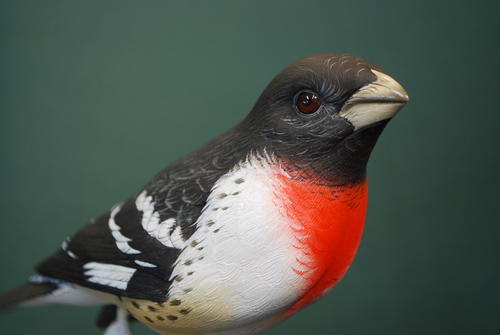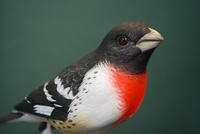Rose-breasted Grosbeak Part One
In Part One, Bob removes everything that doesn't look like a grosbeak. Then he makes what's left look more like one.

Grosbeaks have always been some of my favourite birds. The rose-breasted grosbeak has more striking plumage than the others, with a tuxedo suit and reddish-pink bib that gives it a sharp transition in colors. Despite the flashiness, I’ve always found it to be a difficult bird to find, even when I hear one in an old dead tree singing its heart out.
For this carving, I’ll present the grosbeak in a spring setting on a birch branch. I will give it plenty of movement by turning the head to the right, flipping the tail to the right, and dropping the left wing. The right wing will be over the bird’s back. This will give the impression of the bird getting ready to take off from his perch.
I do most of my initial carving in what I refer to as “straight angle” cuts. This lets me remove all the unwanted wood quickly and keep the carving balanced during the initial stages. I have found that if I start rounding the bird too soon, I end up taking off too much wood from one side or the other.
The painting portion of this project is continued in Part Two from the Spring 2015 issue.
Bob Lavender is a retired Canadian Forces military cook residing in Saskatoon, Saskatchewan. He has been carving competitively since 1987 and has been a consistent blue-ribbon winner across North America.
Read the rest of this article in Wildfowl Carving Magazine’s Winter 2015 issue!
YOUR RECENTLY VIEWED ARTICLES
Free tutorials, expert tips, exclusive partner offers, and more straight to your inbox!
foxyed
Jun 18, 2018
I think this was a great article and enjoyed carving so much that I carved two. See photos
Member 3655706
Jan 15, 2018
This was a great project to carve. Attached is my finished project. Ed
Member 6462476
Aug 21, 2017
I enjoyed this article and proceeded to carve this bird.
foxyed
Jul 24, 2017
I have just finished my Rose-breasted Grosbeak and am happy with results. Mounted on a carved branch
Report Inappropriate Comment
Are you sure you would like to report this comment? It will be flagged for our moderators to take action.
Thank you for taking the time to improve the content on our site.



